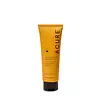What's inside
What's inside
 Key Ingredients
Key Ingredients

No key ingredients
 Benefits
Benefits

 Concerns
Concerns

 Ingredients Side-by-side
Ingredients Side-by-side

Water
Skin ConditioningSodium Cocoyl Isethionate
CleansingGlyceryl Stearate Se
EmulsifyingHydroxypropyl Starch Phosphate
Cocos Nucifera Oil
MaskingDecyl Glucoside
CleansingGlyceryl Oleate
EmollientGlycerin
HumectantPaeonia Lactiflora Root Extract
Skin ConditioningChamomilla Recutita Flower Extract
MaskingAnthemis Nobilis Flower Oil
MaskingRubus Fruticosus Fruit Extract
AstringentEuterpe Oleracea Fruit Extract
Rosa Canina Fruit Extract
AstringentCalendula Officinalis Flower Extract
MaskingAspalathus Linearis Leaf Extract
Skin ConditioningPunica Granatum Extract
AstringentArgania Spinosa Callus Culture Extract
Skin ConditioningJojoba Esters
EmollientHydrolyzed Jojoba Esters
Skin ConditioningLecithin
EmollientIsomalt
HumectantSclerotium Gum
Emulsion StabilisingGlycerophosphoinositol Lysine
Glyceryl Caprylate
EmollientDisodium Coco-Glucoside Citrate
EmulsifyingSodium Lauroyl Lactylate
EmulsifyingEthylhexylglycerin
Skin ConditioningPhenethyl Alcohol
MaskingWater, Sodium Cocoyl Isethionate, Glyceryl Stearate Se, Hydroxypropyl Starch Phosphate, Cocos Nucifera Oil, Decyl Glucoside, Glyceryl Oleate, Glycerin, Paeonia Lactiflora Root Extract, Chamomilla Recutita Flower Extract, Anthemis Nobilis Flower Oil, Rubus Fruticosus Fruit Extract, Euterpe Oleracea Fruit Extract, Rosa Canina Fruit Extract, Calendula Officinalis Flower Extract, Aspalathus Linearis Leaf Extract, Punica Granatum Extract, Argania Spinosa Callus Culture Extract, Jojoba Esters, Hydrolyzed Jojoba Esters, Lecithin, Isomalt, Sclerotium Gum, Glycerophosphoinositol Lysine, Glyceryl Caprylate, Disodium Coco-Glucoside Citrate, Sodium Lauroyl Lactylate, Ethylhexylglycerin, Phenethyl Alcohol
Water
Skin ConditioningSodium Lauroyl Methyl Isethionate
CleansingGlycerin
HumectantGlyceryl Stearate Se
EmulsifyingXanthan Gum
EmulsifyingChamomilla Recutita Flower Extract
MaskingSodium Hyaluronate
HumectantCitrus Aurantium Dulcis Flower Extract
Skin ConditioningJasminum Officinale Flower Extract
MaskingArnica Montana Flower Extract
MaskingSimmondsia Chinensis Seed Oil
EmollientPhospholipids
Skin ConditioningGlyceryl Caprylate
EmollientGlyceryl Undecylenate
EmollientMaltodextrin
AbsorbentPropanediol
SolventSodium Phytate
Trisodium Ethylenediamine Disuccinate
Ethylhexylglycerin
Skin ConditioningPotassium Sorbate
PreservativeSodium Benzoate
MaskingCitric Acid
BufferingWater, Sodium Lauroyl Methyl Isethionate, Glycerin, Glyceryl Stearate Se, Xanthan Gum, Chamomilla Recutita Flower Extract, Sodium Hyaluronate, Citrus Aurantium Dulcis Flower Extract, Jasminum Officinale Flower Extract, Arnica Montana Flower Extract, Simmondsia Chinensis Seed Oil, Phospholipids, Glyceryl Caprylate, Glyceryl Undecylenate, Maltodextrin, Propanediol, Sodium Phytate, Trisodium Ethylenediamine Disuccinate, Ethylhexylglycerin, Potassium Sorbate, Sodium Benzoate, Citric Acid
Alternatives
Ingredients Explained
These ingredients are found in both products.
Ingredients higher up in an ingredient list are typically present in a larger amount.
Chamomilla Recutita Flower Extract comes from the Chamomile flower.
Chamomile is rich in antioxidants and has anti-inflammatory properties. Several compounds found in chamomile help with soothing, such as bisbolol.
Antioxidant components in chamomile make it an effective ingredient to help slow the signs of aging. Antioxidants help fight free-radical molecules, or molecules that may damage your skin.
Essential oils from chamomile have been found to improve wound healing due to its antimicrobial properties.
Ancient Greeks and Egyptians used Chamomile to treat skin redness and dryness. Chamomile has also been used to help treat stomach issues.
Learn more about Chamomilla Recutita Flower ExtractEthylhexylglycerin (we can't pronounce this either) is commonly used as a preservative and skin softener. It is derived from glyceryl.
You might see Ethylhexylglycerin often paired with other preservatives such as phenoxyethanol. Ethylhexylglycerin has been found to increase the effectiveness of these other preservatives.
Glycerin is already naturally found in your skin. It helps moisturize and protect your skin.
A study from 2016 found glycerin to be more effective as a humectant than AHAs and hyaluronic acid.
As a humectant, it helps the skin stay hydrated by pulling moisture to your skin. The low molecular weight of glycerin allows it to pull moisture into the deeper layers of your skin.
Hydrated skin improves your skin barrier; Your skin barrier helps protect against irritants and bacteria.
Glycerin has also been found to have antimicrobial and antiviral properties. Due to these properties, glycerin is often used in wound and burn treatments.
In cosmetics, glycerin is usually derived from plants such as soybean or palm. However, it can also be sourced from animals, such as tallow or animal fat.
This ingredient is organic, colorless, odorless, and non-toxic.
Glycerin is the name for this ingredient in American English. British English uses Glycerol/Glycerine.
Learn more about GlycerinGlyceryl Caprylate comes from glycerin and caprylic acid, a fatty acid from coconut. It has emollient and emulsifier properties.
As an emollient, it helps hydrate your skin. Emollients work by creating a barrier on your skin to trap moisture in, helping to keep your skin soft and smooth.
On the other hand, emulsifiers prevent ingredients (such as oil and water) from separating.
Learn more about Glyceryl CaprylateGlyceryl Stearate Se is a self-emulsifying (SE) form of glyceryl stearate. Self-emusifying means this ingredient automatically blends with water. It is an emulsifier, emollient, and cleansing agent.
As an emulsifier, Glyceryl Stearate Se prevents ingredients such as oil and water from separating. It is also a surfactant, meaning it helps cleanse the skin. Surfactants help gather oil, dirt, and other pollutants so they may be rinsed away easily.
Emollients help your skin stay smooth and soft. It does so by creating a film on top of the skin that helps trap moisture in.
Learn more about Glyceryl Stearate SeWater. It's the most common cosmetic ingredient of all. You'll usually see it at the top of ingredient lists, meaning that it makes up the largest part of the product.
So why is it so popular? Water most often acts as a solvent - this means that it helps dissolve other ingredients into the formulation.
You'll also recognize water as that liquid we all need to stay alive. If you see this, drink a glass of water. Stay hydrated!
Learn more about Water